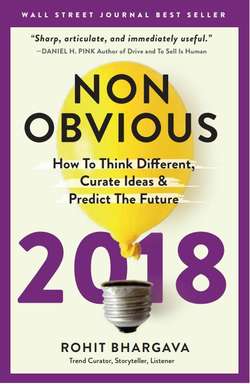Читать книгу Non-Obvious 2018 Edition - Рохит Бхаргава - Страница 69
На сайте Литреса книга снята с продажи.
STEP 3—Elevating
ОглавлениеWhen I stepped back to look through my initial list of possible trend ideas (which usually numbers about seventy-five once I make it through the first two phases of the Haystack Method), there were several other trend concepts that seemed to possibly be related to this idea of Addictive Design.
One of them was a grouping of stories that were all about the use of gamification techniques to help people of all ages learn new skills. For that group, I had an index card on top that said “Gamified Learning,” and inside were stories about the Khan Academy using badges to inspire learning and a startup called Curious that was making learning addictive by creating bite-sized pieces of learning on interesting topics.
Another group of ideas was inspired by a book I had read earlier that year called Salt Sugar Fat by Michael Moss, which had focused on the idea of addiction related to food. The book exposed how snack foods, such as Oreos and Cheetos, had been created to offer a “bliss point” that mimicked the sensations of addiction in most people.3 Along with the book, I also had several other articles with similar themes that were grouped together and stapled with an index card that said “Irresistible Food.”
In this third phase of elevation, I realized that what seemed like three unique ideas (Gamified Learning, Addictive Design, and Irresistible Food), might actually be elements of a single trend. This broader idea seemed to describe a growing instance where experiences and products of multiple types were increasingly being created to be intentionally addictive.
I put all the stories for each of these three aggregated concepts together and called the elevated grouping “Ubiquitous Addiction.”
